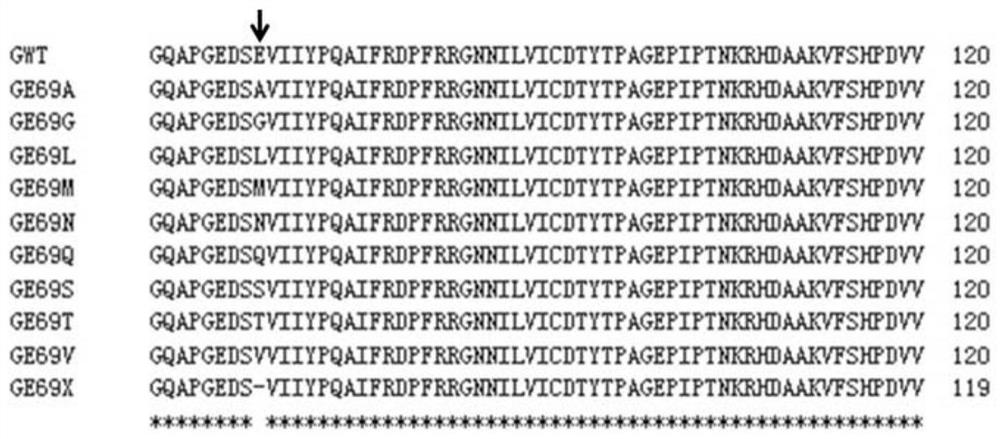Glutamine synthetase mutant and application of glutamine synthetase mutant in culturing glufosinate-ammonium-resistant plant variety
A glutamine and synthetase technology, applied in the field of genetic engineering, can solve the problems of affecting plant growth and development, glufosinate-ammonium tolerance is not enough for commercial application, interfering with plant nitrogen metabolism, etc., to achieve the effect of satisfying growth and development
- Summary
- Abstract
- Description
- Claims
- Application Information
AI Technical Summary
Problems solved by technology
Method used
Image
Examples
Embodiment 1
[0099] The rice (Oryza sativa) glutamine synthetase (GS1) mutant provided in this embodiment is composed of the wild-type rice glutamine synthetase itself (named OWT, the amino acid sequence is shown in SEQ ID NO.1, and the encoding nucleus The nucleotide sequence is that the 69th amino acid residue E of SEQ ID NO.6) is mutated into A, C, D, F, G, H, I, K, L, M, N, P, Q, R, S, T, V, Y or deletion, the obtained rice GS1 mutants were named OE69A, OE69C, OE69D, OE69F, OE69G, OE69H, OE69I, OE69K, OE69L, OE69M, OE69N, OE69P, OE69Q, OE69R, OE69S, OE69T, OE69V, OE69Y, and OE69X.
[0100] Comparison of amino acid sequences of rice GS1 mutants OE69A, OE69C, OE69D, OE69F, OE69G, OE69H, OE69I, OE69K, OE69L, OE69M, OE69N, OE69P, OE69Q, OE69R, OE69S, OE69T, OE69V, OE69Y and OE69X with wild-type rice GS1 For example figure 1 As shown in the figure: the position indicated by the arrow is the mutation site.
[0101] In this example, the coding sequence of each rice GS1 mutant is at the po...
Embodiment 2
[0105] The soybean (Glycine max) GS1 mutant provided in this example is composed of the wild-type soybean GS1 itself (named GWT, the amino acid sequence is shown in SEQ ID NO.3, and the encoding nucleotide sequence is SEQ ID NO.8). The 69th position (corresponding to the 69th position of the reference sequence (SEQ ID NO.1)) is obtained by mutating the amino acid residue E to A, G, L, M, N, Q, S, T, V or deleting it. The obtained soybean GS1 mutants were named GE69A, GE69G, GE69L, GE69M, GE69N, GE69Q, GE69S, GE69T, GE69V and GE69X, respectively.
[0106] The amino acid sequence alignment of soybean GS1 mutants GE69A, GE69G, GE69L, GE69M, GE69N, GE69Q, GE69S, GE69T, GE69V and GE69X and wild-type soybean GS1 GWT is as follows: figure 2 As shown in the figure: the position indicated by the arrow is the mutation site.
[0107] The coding sequences of soybean GS1 mutants GE69A, GE69G, GE69L, GE69M, GE69N, GE69Q, GE69S, GE69T, GE69V and GE69X provided in this example correspond to...
Embodiment 3
[0112] The maize (Zea mays) GS1 mutant provided in this example is composed of the wild-type maize GS1 itself (named ZWT, the amino acid sequence is shown in SEQ ID NO.2, and the encoding nucleotide sequence is SEQ ID NO.7). The 69th position (corresponding to the 69th position of the reference sequence (SEQ ID NO.1)) is mutated from amino acid residue E to A, C, D, F, G, H, I, K, L, M, N, P , Q, R, S, T, V, Y or deleted. The maize GS1 mutants obtained were named ZE69A, ZE69C, ZE69D, ZE69F, ZE69G, ZE69H, ZE69I, ZE69K, ZE69L, ZE69M, ZE69N, ZE69P, ZE69Q, ZE69R, ZE69S, ZE69T, ZE69V, ZE69Y and ZE69X.
[0113] Amino acid sequence comparison of maize GS1 mutants ZE69A, ZE69C, ZE69D, ZE69F, ZE69G, ZE69H, ZE69I, ZE69K, ZE69L, ZE69M, ZE69N, ZE69P, ZE69Q, ZE69R, ZE69S, ZE69T, ZE69V, ZE69Y and ZE69X and wild type maize GS1ZW For example image 3 As shown in the figure: the position indicated by the arrow is the mutation site.
[0114] In this example, the coding sequence of each maize...
PUM
 Login to View More
Login to View More Abstract
Description
Claims
Application Information
 Login to View More
Login to View More - R&D
- Intellectual Property
- Life Sciences
- Materials
- Tech Scout
- Unparalleled Data Quality
- Higher Quality Content
- 60% Fewer Hallucinations
Browse by: Latest US Patents, China's latest patents, Technical Efficacy Thesaurus, Application Domain, Technology Topic, Popular Technical Reports.
© 2025 PatSnap. All rights reserved.Legal|Privacy policy|Modern Slavery Act Transparency Statement|Sitemap|About US| Contact US: help@patsnap.com



